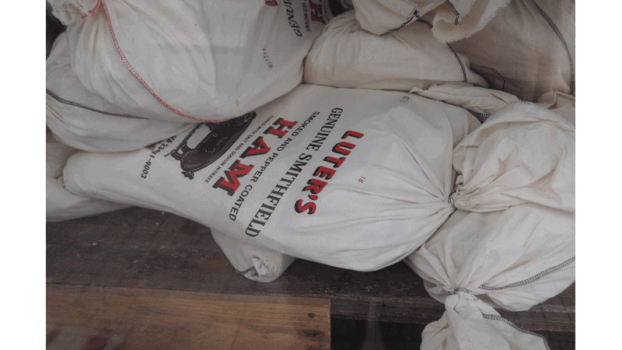End of an era: Smithfield Foods discontinues Genuine Smithfield Ham
Published 2:15 pm Friday, February 9, 2024
|
Getting your Trinity Audio player ready...
|
Smithfield Foods has stopped producing the brand-name Genuine Smithfield Hams that have become synonymous with the company’s namesake town.
“We have decided to discontinue production of Smithfield Genuine Hams in 2024,” Smithfield Vice President of Corporate Affairs Jim Monroe confirmed in a Jan. 24 email to The Smithfield Times.
“Consumer preferences have shifted and other Smithfield hams are in much higher demand by a wide margin,” Monroe said. “Spiral-cut smoked hams, in particular, are wildly popular with consumers.”
According to Monroe, the smokehouse Smithfield Foods invested $1.8 million to build in 2019, replacing an older facility housing the company’s Genuine Smithfield Ham production, will be repurposed to instead produce Smithfield’s mild-cure hams, which are similar but require only four months of aging rather than the minimum six mandated under a nearly century-old state law.
In 1926, state lawmakers fearful of outsiders looking to enter Virginia’s meatpacking industry decreed hams could only be branded as “Genuine Smithfield” if created using the “long-cure, dry salt method” and aged a minimum of six months, all “within the corporate limits of the town of Smithfield.”
“I understand that Smithfield Foods has made a business decision to discontinue the ‘Genuine’ Smithfield ham due to changing demand. While the mild-cure ham does not satisfy the proverbial letter of the law that describes a ‘Genuine’ ham, the product will be cured and produced in the Town of Smithfield,” said Smithfield Mayor Steve Bowman. “In my opinion, it remains a Smithfield ham that carries the name of our town and their corporation throughout vast reaches of the world, and we continue to be proud to be the home of the headquarters of this great company.”
A limited number of Genuine Smithfield Hams remain available for purchase at Taste of Smithfield, a company-affiliated store and restaurant located on Main Street.
“Once this inventory is depleted, they will no longer be available,” Monroe said.
Smithfield Foods’ discontinuation of its Genuine Smithfield brand was preceded by the company’s decision last year to cease operating its Smithfield Marketplace website that had previously allowed the buying and shipping of brand-name Genuine Smithfield Hams and other products online. Monroe, last fall, told the Times that the company’s online store had been serving “a relatively small number of people” and that the volume of orders “did not justify” the website’s ongoing maintenance.
“Companies often adjust their product lines to align with market demand,” said Thomas Schneider, a professor of finance at Old Dominion University. “When deciding to discontinue a product, companies will analyze a variety of factors, including the proportion of customers likely to be retained through alternative product offerings. These two products seem to occupy a similar space. Moves like this make sense as companies continue to adapt their product portfolios to reflect evolving consumer preferences and market trends.”
Still, it’s the end of an era for a delicacy that, legend has it, more than once found its way to England atop Queen Victoria’s dining table in the 1800s.
The history
Capt. Mallory Todd, a Bermuda merchant who moved to Smithfield in 1767, is credited with originating the salt-cure technique and six-month aging process that distinguishes a Genuine Smithfield Ham from its competitors. According to Helen Haverty King’s book, “Historical Notes on Isle of Wight County, Virginia,” the Genuine Smithfield brand uses a long cut of meat, from butt to shank, and is not squared off like most other country hams. In the winter, hams are salted and allowed to lie for two weeks. Then the process is repeated to allow the salt to penetrate almost to the bone, and the ham is smoked with hardwood fire, again for two weeks. The hams then undergo a six-month aging process during the summer months and are traditionally ready to eat by Thanksgiving.
According to King’s book, a shipment invoice dated 1779 proves Todd had entered the ham business as early as April 30 of that year. Commerce Street, where Smithfield Foods is now headquartered, in Todd’s day consisted of a footpath leading to a public boat landing on the Pagan River from which Todd did much of his business.
After Todd came P.D. Gwaltney Jr., who, according to King’s book, had firmly established himself in the ham industry by 1907. Five years earlier, in 1902, one of P.D. Gwaltney’s Smithfield hams went overlooked, and for the next 20 years hung from a rafter inside a packing house. When Gwaltney discovered the ham had survived the 1921 fire that destroyed two blocks of Commerce Street, he fashioned a brass collar for it, calling it his “pet,” and took it on tour across the nation, touting it as evidence of the preservative powers of the Smithfield curing method. The Isle of Wight County Museum gained custody of Gwaltney’s “world’s oldest ham” in 1985, and will be getting another Genuine Smithfield Ham this year donated by Smithfield Foods, Monroe said.
The 1926 law defining Genuine Smithfield Hams, according to Museum Director Jennifer England and the museum’s literature, came about a year after James Sprigg, a World War I veteran, relocated from Texas to Virginia and, in 1925, purchased The Smithfield Co. Inc., a Gwaltney competitor. The law was passed in response to locals’ fear of an outsider potentially creating an inferior product under the Smithfield name.
Sprigg’s only encounter with a Smithfield Ham, at that point, had been “a Chapman Ham he had been sent while he was in Texas,” a booklet produced by the museum in 1993 states. “The cook never did get the cooking process right and eventually the ham was given to the dog for his Christmas dinner.”
“Smithfield hams take many months to cure so there was no inventory to begin his ham business,” the booklet states. “James Sprigg had an inventive mind and soon decided to purchase hams from the other companies and learn how to cook them properly and sell them cooked while he was waiting for his first hams to cure.”
His company survived its first year but by the second, when he had his first cured hams to sell, Virginia’s General Assembly had enacted the Genuine Smithfield Ham law. The law left Sprigg, who’d been living and working out of a two-room plant on nine acres just across the Pagan River outside the town’s limits, with only two choices: move into town or stop using the Smithfield brand name.
Gwaltney died in 1936, the same year as Smithfield Foods’ founding. By 1972, the last of his living descendants had retired from the meat industry. In 1983, Smithfield Foods, under former CEO Joseph Luter III, purchased the Gwaltney brand.






